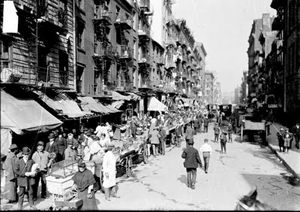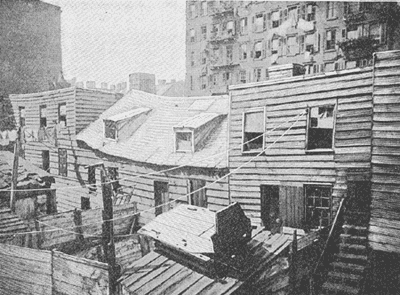Filthy Cities, BBC Two | reviews, news & interviews
Filthy Cities, BBC Two
Filthy Cities, BBC Two
Dan Snow traces New York's rise from sewer to penthouse
Dan Snow's toxic trilogy climaxed in New York, where he crawled voyeuristically through the rotten core of the Big Apple. It was part Discovery Channel documentary, part Gangs of New York dirty realism, as Snow took a frankly indecent relish in regaling us with tales of death, disease and raw capitalism at its baby-eating worst.
In the event, studying the development of America's greatest city from the bottom up, as it were, made perfect sense. In the mid-19th century, New York was a crude frontier settlement that occupied merely the southernmost tip of Manhattan island. Immigrants, for example the 650,000 Irish who were fleeing the potato famine back home, were dumped into stinking tenements run by fat-cat bosses and slum landlords who bullied and robbed them.
Lack of plumbing, sewers or running water meant it was open season for typhus and cholera, and the poor huddled masses played host to an interesting variety of wildlife including bedbugs and disease-carrying lice. The streets were littered with dead cats, rotting horses and excrement, while freely grazing pigs were the nearest thing to a street-cleaning service. Taxpayers' money was being embezzled by bent politicians like William "Boss" Tweed. Of course, some say 21st-century Wall Street isn't much better (New York's Lower East Side, 1910, pictured below).
 A larger than average CGI budget allowed Snow to juxtapose himself with tattered wretches from the century before last, and on one occasion three Dan Snows occupied a single tenement room, to illustrate the concept of overcrowding. New York's evolution from satanic swamp, where butchers sold customers rotting meat cured with borax and clothing dye, to thrusting turbo-metropolis was signposted by key technological developments which transformed the city, then rippled out across the industrialised world. Having been poorly lit by noxious coal gas, New York became a sparkling new wonderland thanks to Thomas Edison and his amazing electric light, though Edison's Direct Current was speedily supplanted by Nikola Tesla's longer-range Alternating Current. Despicably, Edison tried to sow doubt about AC by using it to kill Topsy, the Coney Island elephant, preserving the animal's demise on film (the squalid Five Points district, late 19th century, pictured below).
A larger than average CGI budget allowed Snow to juxtapose himself with tattered wretches from the century before last, and on one occasion three Dan Snows occupied a single tenement room, to illustrate the concept of overcrowding. New York's evolution from satanic swamp, where butchers sold customers rotting meat cured with borax and clothing dye, to thrusting turbo-metropolis was signposted by key technological developments which transformed the city, then rippled out across the industrialised world. Having been poorly lit by noxious coal gas, New York became a sparkling new wonderland thanks to Thomas Edison and his amazing electric light, though Edison's Direct Current was speedily supplanted by Nikola Tesla's longer-range Alternating Current. Despicably, Edison tried to sow doubt about AC by using it to kill Topsy, the Coney Island elephant, preserving the animal's demise on film (the squalid Five Points district, late 19th century, pictured below).
 Meanwhile, running water was brought to New York by damming the Croton River and building a spectacular aqueduct to carry the water 40 miles to the city, though at first only the uptown rich could afford it. The downtown drones continued to flounder in a sea of merde. All this water needed somewhere to overflow into, so the city found itself equipped, perforce, with a spiffing new sewage system. Meanwhile New York was still surrounded on all sides by water heaving with untreated sewage, which was being pumped nonchalantly into the East and Hudson rivers. Before you could say "bada-bing!", huge sewage treatment plans sprang up, and Richard H Gould introduced the British invention of "activated sludge" which used bacteria to purify the water.
Meanwhile, running water was brought to New York by damming the Croton River and building a spectacular aqueduct to carry the water 40 miles to the city, though at first only the uptown rich could afford it. The downtown drones continued to flounder in a sea of merde. All this water needed somewhere to overflow into, so the city found itself equipped, perforce, with a spiffing new sewage system. Meanwhile New York was still surrounded on all sides by water heaving with untreated sewage, which was being pumped nonchalantly into the East and Hudson rivers. Before you could say "bada-bing!", huge sewage treatment plans sprang up, and Richard H Gould introduced the British invention of "activated sludge" which used bacteria to purify the water.
 That wasn't all. Snow took a spin around Manhattan (pictured right) in a nifty little Detroit Electric car, a tantalising reminder of how motor vehicles were powered by electricity before the internal combustion muscled in and - in the person of Henry Ford and his Model-T - took over the personal transport revolution. We were introduced to early Hoovers and prototype refrigerators ("New York was swept by a tidal wave of consumerism," gushed Dan). And we met Mr Thomas Midgley, the visionary boffin who introduced lead to petrol to make engines run more smoothly, then brilliantly added the ozone-destroying CFC, Freon, to fridges. How come this guy isn't up there with Al Capone and Charles Manson in America's all-time roll call of infamy?
That wasn't all. Snow took a spin around Manhattan (pictured right) in a nifty little Detroit Electric car, a tantalising reminder of how motor vehicles were powered by electricity before the internal combustion muscled in and - in the person of Henry Ford and his Model-T - took over the personal transport revolution. We were introduced to early Hoovers and prototype refrigerators ("New York was swept by a tidal wave of consumerism," gushed Dan). And we met Mr Thomas Midgley, the visionary boffin who introduced lead to petrol to make engines run more smoothly, then brilliantly added the ozone-destroying CFC, Freon, to fridges. How come this guy isn't up there with Al Capone and Charles Manson in America's all-time roll call of infamy?
- Watch Filthy Cities on BBC iPlayer
 Find Dan Snow on Amazon
Find Dan Snow on Amazon
Explore topics
Share this article
more TV
 Blue Lights Series 2, BBC One review - still our best cop show despite a slacker structure
The engaging Belfast cops are less tightly focused this time around
Blue Lights Series 2, BBC One review - still our best cop show despite a slacker structure
The engaging Belfast cops are less tightly focused this time around
 Baby Reindeer, Netflix review - a misery memoir disturbingly presented
Richard Gadd's double traumas are a difficult watch but ultimately inspiring
Baby Reindeer, Netflix review - a misery memoir disturbingly presented
Richard Gadd's double traumas are a difficult watch but ultimately inspiring
 Anthracite, Netflix review - murderous mysteries in the French Alps
Who can unravel the ghastly secrets of the town of Lévionna?
Anthracite, Netflix review - murderous mysteries in the French Alps
Who can unravel the ghastly secrets of the town of Lévionna?
 Ripley, Netflix review - Highsmith's horribly fascinating sociopath adrift in a sea of noir
Its black and white cinematography is striking, but eventually wearying
Ripley, Netflix review - Highsmith's horribly fascinating sociopath adrift in a sea of noir
Its black and white cinematography is striking, but eventually wearying
 Scoop, Netflix review - revisiting a Right Royal nightmare
Gripping dramatisation of Newsnight's fateful Prince Andrew interview
Scoop, Netflix review - revisiting a Right Royal nightmare
Gripping dramatisation of Newsnight's fateful Prince Andrew interview
 RuPaul’s Drag Race UK vs the World Season 2, BBC Three review - fun, friendship and big talents
Worthy and lovable winners (no spoilers) as the best stay the course
RuPaul’s Drag Race UK vs the World Season 2, BBC Three review - fun, friendship and big talents
Worthy and lovable winners (no spoilers) as the best stay the course
 This Town, BBC One review - lurid melodrama in Eighties Brummieland
Steven Knight revisits his Midlands roots, with implausible consequences
This Town, BBC One review - lurid melodrama in Eighties Brummieland
Steven Knight revisits his Midlands roots, with implausible consequences
 Passenger, ITV review - who are they trying to kid?
Andrew Buchan's screenwriting debut leads us nowhere
Passenger, ITV review - who are they trying to kid?
Andrew Buchan's screenwriting debut leads us nowhere
 3 Body Problem, Netflix review - life, the universe and everything (and a bit more)
Mind-blowing adaptation of Liu Cixin's novel from the makers of 'Game of Thrones'
3 Body Problem, Netflix review - life, the universe and everything (and a bit more)
Mind-blowing adaptation of Liu Cixin's novel from the makers of 'Game of Thrones'
 Manhunt, Apple TV+ review - all the President's men
Tobias Menzies and Anthony Boyle go head to head in historical crime drama
Manhunt, Apple TV+ review - all the President's men
Tobias Menzies and Anthony Boyle go head to head in historical crime drama
 The Gentlemen, Netflix review - Guy Ritchie's further adventures in Geezerworld
Riotous assembly of toffs, gangsters, travellers, rogues and misfits
The Gentlemen, Netflix review - Guy Ritchie's further adventures in Geezerworld
Riotous assembly of toffs, gangsters, travellers, rogues and misfits
 Oscars 2024: politics aplenty but few surprises as 'Oppenheimer' dominates
Christopher Nolan biopic wins big in a ceremony defined by a pink-clad Ryan Gosling and Donald Trump seeing red
Oscars 2024: politics aplenty but few surprises as 'Oppenheimer' dominates
Christopher Nolan biopic wins big in a ceremony defined by a pink-clad Ryan Gosling and Donald Trump seeing red

Add comment